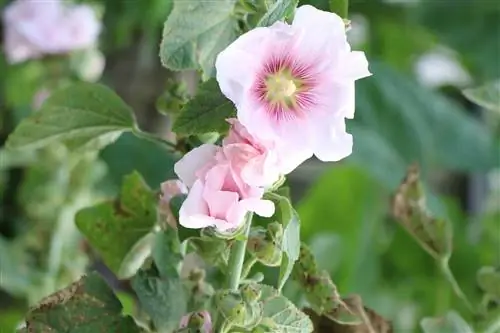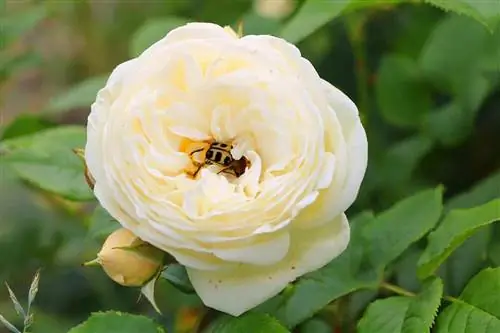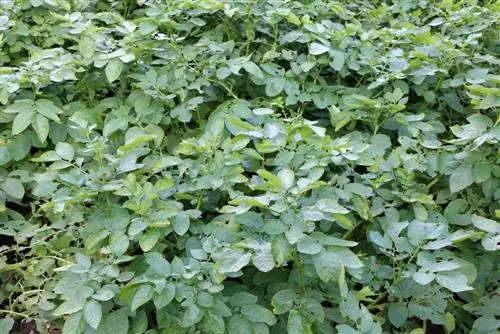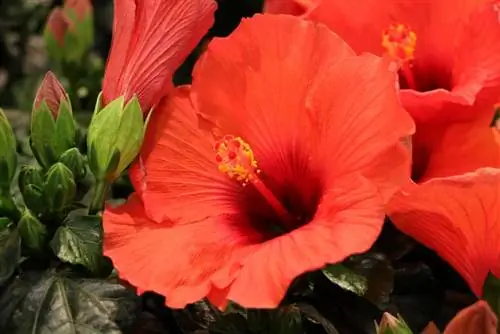- Author admin [email protected].
- Public 2023-12-17 03:39.
- Last modified 2025-06-01 06:48.
The Alcea Rosea is a plant that can be found in many gardens. It is often used in rural areas and in gardens where things can get a little wilder and more disorderly. It is usually referred to as hollyhock. Other names would be farmer's rose, hollyhock or poplar rose. Even though this plant has the word “rose” in its name, the flower is less reminiscent of a rose and more of a calyx. It is therefore part of the mallow family and is unfortunately occasionally susceptible to diseases and pests.
The hollyhock is particularly susceptible to mallow rust. What sounds quite harmless is actually a dangerous fungal disease that can cause serious problems to the beautiful mallow plant. Sometimes it can die completely if there is a severe infestation.
Mallow rust - appearance and control
Mallow rust appears as red-brown pustules, which are first noticeable on the underside of the leaves. There are also yellow spots that are relatively small and can be found on the upper side of the leaves. As a rule, this fungus appears in spring. However, it can stay on the plant throughout the year and, in the worst case, even overwinter. Effective control is therefore essential.
In order for this to happen from scratch, it is important that all affected leaves are removed immediately. If these fall on the ground, the fungus could spread across the floor. In addition, the affected leaves should not be disposed of in the compost, but always in the residual waste. In addition, the hollyhocks should be watered regularly with well-ripened compost that is dissolved in water. It is also very good if the soil in which the hollyhock grows does not contain too much nitrogen. Mallow rust loves nitrogen and spreads particularly quickly. You should also pay attention to an airy and sunny location. If the plants are not placed too closely together, mallow rust will find it difficult to spread to other plants. In addition, only strong plants should always be used, as they can defend themselves better against the fungus.
Countermeasures for mallow rust
A good way to generally avoid fungi is to water the plants in the morning. If you water early, you give the plants the opportunity to absorb the water throughout the day. The water does not stand for long and therefore cannot form mold or fungi. And if mallow rust cannot be combated despite vigorous pruning of the plants and all other precautionary measures, sulfur-based fungicides could be a good alternative. These pesticides are quite intensive in their effect and are likely to achieve good results. However, it can happen that these not only kill the pests, but also useful garden helpers. Their use should therefore be carefully considered and only done if other methods have not been successful. This helps against mallow rust:
- remove affected leaves immediately
- Regularly place well-ripened compost around the hollyhocks
- Watering plants in the morning
- Use fungicides for intensive control
Tip:
When using pesticides, appropriate protective clothing should always be worn. In addition, small children should be kept away from the plants so that they cannot put any treated plant parts in their mouths.
Other pests
Possible pests:
- Mallow flea beetle
- Mallow shrew
- Caterpillars
- Snails
Holes in the leaves of plants can come from beetles such as the mallow flea beetle. The little crawler is metallic blue, green or black and has small red legs. If this beetle occurs, it can simply be collected from the hollyhock as it rarely occurs in large numbers.
Tip:
No chemical agents should be used against the mallow flea beetle. It is on the list of endangered species and therefore cannot be eliminated using chemicals.
Another pest is the mallow shrew. This is also a beetle, but it has a small, pointed proboscis and is therefore often referred to as a “mouse”. By laying their eggs in the stems, small feeding tunnels form there, which damage the plant. Larger holes in the leaves, however, indicate caterpillars. Among other things, there is the mallow fathead butterfly, which can cause a lot of damage to the popular plant. There are also snails, which can also cause a lot of damage, but they usually operate from the ground and leave a clearly visible trail of slime. The same applies here: collecting the pests quickly prevents too much damage.
Diseases
The best-known disease of hollyhocks is wilt disease. This term covers several diseases that can affect a wide variety of plants in very different ways. However, this always means the death of plants, which is caused by fungi or bacteria or by a lack of water. The wilt disease is triggered by cutting off the water supply. Even if watered regularly, the hollyhock cannot absorb the water. The reason for this is that the channels are blocked or even destroyed. This can be caused, among other things, by toxins that come from fungi and bacteria. If wilt disease occurs due to regular lack of water, this can be remedied quite easily. This usually happens in the winter months, when, as is well known, there is little or no watering. Affected plants should be watered or - if the disease is already well advanced - simply removed.
Tip:
There are few ways to stop wilt disease when it is caused by bacteria and fungi. Therefore, affected plants should be removed and replaced.
Frequently asked questions
Is the hollyhock particularly susceptible?
Is the hollyhock particularly susceptible? - Actually no more than other plants. If the plants are not too crowded, watered early and small pests are picked up quickly, pest infestation can be kept to a very manageable level.
What diseases occur?
The best-known disease is wilt disease. It can be caused by a lack of water or by bacteria or fungi. If bacteria and fungi are responsible, they prevent the plant from absorbing water. In such a case, more intensive watering would no longer be sufficient.
How and where does the hollyhock grow best?
The hollyhock is most happy about a sunny spot where it can spread undisturbed. If it is watered regularly and fresh compost is added every now and then to provide nutrients, there is hardly anything in the way of a colorful flower.
What you should know about hollyhocks soon
Location
- The hollyhock likes a sunny to partially shaded location, in the rain shadow of buildings.
- In the shadows she cares. The flowers stand well in front of a fence as they are protected and supported if necessary.
- As a solitary plant or without a support, it is best to tie it up so that the long stem with the many flowers does not break.
- An airy, not too cramped stand prevents mallow rust.
Planting substrate
- The plant substrate should be dry to fresh, nutrient-rich, well-drained and slightly acidic to alkaline.
- Calcareous soil is also tolerated.
Watering and fertilizing
- The hollyhock must be watered sufficiently. However, it doesn't like standing water, so you shouldn't overdo it with watering.
- In spring (April/May) the hollyhock needs fertilizer. It needs a lot of nitrogen for its growth.
Cutting
- You cut down the hollyhock either before seeds form or after winter.
- Pruning immediately after flowering can extend the life of the plant.
Propagation
- The hollyhocks multiply on their own if you don't cut off the inflorescences. In the fall you just have to open them and rub them on with your hands.
- You scatter the seeds into the bed and rake them in lightly. Nature takes care of the rest.
- You can also sow in planting bowls or small planters.
- Growing is easy and almost always successful.






